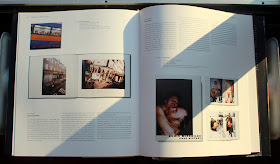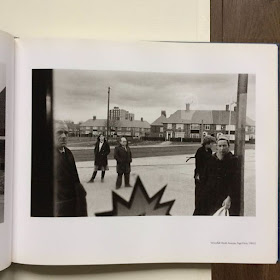Tom Wood
All Zones Off Peak
Photographs: TOM WOOD
Publisher: Dewi Lewis Publishing
96 pages
Year: 1998
Comments: Hardcover with dust jacket, 248 mm x 298 mm.Ref Parr & Badger p308 the photobook Vol 2.
Fantastic concentration... an epic of the everyday – Mark Haworth Booth
I can not think of a more engaging body of contemporary work – Chris Killip
As good a set of photographs as one sees every five or ten years – if you're lucky – Lee Friedlander
Long out of print All Zones Off Peak is an extraordinary book. Wood spent over fifteen years and shot over 3,000 rolls of film photographing Liverpool and its people from a bus. Visually stunning and dramatically revealing it is a body of work of immense power.
Photographer Study – Tom Wood, All Zones off Peak
All images used in this post are copyrighted to the individual photographer stated and are only being used for educational purposes.
All Zones off Peak (Wood, T. (1998). All Zones off Peak. 1st Edition. England. Dewi Lewis Publishing.) is a body of work by Photographer Tom Wood and was recommended by my Tutor quite a while ago. After much searching and waiting, I finally managed to reserve a copy to view at the Bodleian Library in Oxford.
The book is a result of a 15 year bus journey across Liverpool, where Wood photographs the world beyond the window as well as fellow travellers on the bus and waiting outside.
The first half of the book is all in black and white, mostly taken in the reign of Thatcher’s Government. The subjects appear to mirror the timeless effect of black and white in their everyday grey gestures and postures. Each picture is carefully thought out and composed. Some focus on the passing landscape outside and people going about their everyday life oblivious to the camera. In others he has concentrated on fellow passengers and in some cases has used a combination of the two. One image in particular titled Kensington 1988 was taken on the top deck of a bus. Wood has focused on a shop out of the window but in the top left corner of the frame are the hands of a male passenger reading a book and holding a cigarette. The bus is obviously stationery and he has also captured the bus stop sign with another sign directly above of an arrow pointing “To the Circus”. It is the tiny details like this that make his images so interesting and with each view another detail is revealed to the viewer in the never-ending layers of the story in his pictures.
In each picture it is quite clear that the photographer is a passenger on the bus. Wood captures reflections in the glass, mirrors and parts of the window frame within the photo frame. His ability to capture the sometimes grey expressions of his subjects somehow suggests that the toil of their bus journey mirrors their everyday struggles in their life journey.
1983 (Netherton). Copyright Tom Wood
The second half of the book is in colour and appear more abstract with the use of reflections within reflections but equally still drawing the viewer in and creating a fascinating story.
In the accompanying text Mark Holborn quoted:
“The journey is the oldest narrative device”
It therefore seems quite appropriate that the last picture in the book is one of the photographer standing on the street and photographing the passengers on the bus. It appears that he has alighted at this final destination and is waiting for the bus to move off. Ironically many of the passengers appear to be looking at / watching him as opposed to the other way round.
London Road, City Centre, 1994. Copyright Tom Wood
Bibliography
Wood, T. (1998). All Zones off Peak. 1st Edition. England. Dewi Lewis Publishing.
SATURDAY, 12 JUNE 2010
All Zones Off Peak
This image is taken from Tom Wood’s All Zones Off Peak, a series of photographs taken from bus windows in Liverpool between 1979 and 1997 - years that exactly coincide with an unbroken period of Conservative government. At first glance they read like studies of the disenfranchised of the Northern inner cities. Wood’s bus journeys visually connect the regenerated areas of the city with more neglected, peripheral spaces: the declining high streets, areas of wasteland, cleared slums and abandoned houses of the inner-ring suburbs. But what is really interesting about Wood’s project is the slow-burning, cumulative effect of the series as a whole, a small selection taken from over 3000 rolls of film and 100,000 photographs. These photographs are not about capturing specific moments but the endlessly repeated routines and minimal, wordless communities produced by bus journeys.
Wood used a Leica camera with a quiet shutter and shot from the chest or stomach, allowing him to take photographs unobtrusively, in the manner of Walker Evans’s secretly-taken New York subway portraits. Rather than catching his subjects unawares, though, Wood reveals them in that semi-introspective, blank-faced mode we adopt in routine public spaces. All these unnamed people, absent-mindedly following their fixed timetables and prescribed routes – all inhabiting what Georges Perec called “the infra-ordinary,” the sphere of existence that lies beneath notice or comment, and within which “we sleep through our lives in a dreamless sleep”.
Mundane quote for the day: ‘Objects and words also have hollow places in which a past sleeps, as in the everyday acts of walking, eating, going to bed, in which ancient revolutions slumber.’ - Michel de Certeau
Tom Wood: All Zones Off Peak
July 1999
Stanley Road, Bootle, 1989
Tom Wood was born in Mayo in 1951, grew up in Cowley in Oxford, and then studied painting at Leicester Polytechnic. He moved to Mereyside in 1978 and has taught photography part-time there and as a visiting lecturer while pursuing long-term photographic objects. He has written many books and his work is represented in major public collections including MOMA New York ; International Centre for Photography, New York; and the Victoria & Albert Museum, London.
Tom Wood’s All Zones Off Peak is the culmination of a fifteen year photographic odyssey around Liverpool. From the simple starting point of photographing from a bus, he has created a Joycean vision of the city – a complex, lived-in, living reality.
Jim Vausham
Tom Wood shot more than three thousand rolls of film in realizing this ambitious and compelling project. From the earliest silver prints, to the recently completed large-scale color images, it is a remarkable achievement that explores new ground in photography. With a beauty that catches you unawares, the work delivers an extraordinary picture of the ordinary.
Tom Wood’s art lies in his commitment to the multi-layered lives of people he depicts. Never sneering at them, or appropriating them for some political cause, Wood’s work nevertheless holds a political message. The social realities he portrays are underpinned by the thoughts and dreams of his protagonists; at every instant, the ‘real world’ is open to transformation.
Wood’s only loyalty is to the living city he photographs, the way its people populate and inhabit it, and most of all the ways in which, in every way and everyday ,we move in constant relation to others, known and unknown, living and dead, who also walked these streets and breathed this air.



















Geen opmerkingen:
Een reactie posten